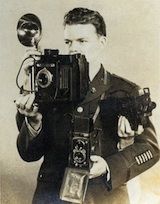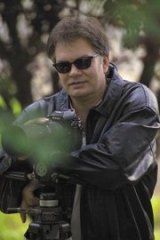- Forum
- General Discussion | Introductions | Off Topic Forum
- Photography General Discussion
- Determining flash settings in manual mode?
Determining flash settings in manual mode?
-

- MLKstudios
- Banned
-
- D800 ;-)
- Followers: 72
- Posts: 4480
-
Points:
2
Post #152787
A medium powered flash has a GN of around 100 feet (at ISO 100). The SB-900 and 580EX-II are closer to 150. A low powered flash is rated around 50-70.
Note that zooming the flash head changes the GN too. So it gets really complicated when using modern equipment.
Ex. for the SB-700. Guide Number rated at 28 (in meters), or 92 (in feet), at ISO 100 at normal 35mm FX setting.
In practice that would be the flash head at full power pointed straight on, and for example you are 16 feet away, and using ISO 100 (and the 35mm FX zoom setting), you'd divide 92 by 16 to get the f/stop (5.75). Any tilt, other ISO, modifier and etc. means you would need to recalculate some impossible factors.
Studio strobes are rated in watts per second. The modifiers used (including reflectors, umbrellas, softboxes, snoots and etc.) have a great affect on their power. A flash meter helps.
Lighting is about learning to SEE and find good light. If you have to work in bad light (ex. a wedding) then you need to know what to add (or subtract) to make the available light look good. That's when flash is a necessity, and not an option.
Matthew L Kees
MLK Studios Photography School
www.MLKstudios.com
[email protected]
"Every artist, was once an amateur"
-

- Imagegourmet
- New Kid On The Block
-
- Nikon D90
- Followers: 19
- Posts: 29
-
Points:
0
Post #152825
Or read this article, www.vividlight.com/articles/1214.htm
-

- MLKstudios
- Banned
-
- D800 ;-)
- Followers: 72
- Posts: 4480
-
Points:
2
Post #152907
Would save you from a flashy looking blowout.
Matthew L Kees
MLK Studios Photography School
www.MLKstudios.com
[email protected]
"Every artist, was once an amateur"
-

- Moe
- Apprentice
-
- Canon 5D Mark III
- Followers: 251
- Posts: 2144
-
Points:
11834
-

- MLKstudios
- Banned
-
- D800 ;-)
- Followers: 72
- Posts: 4480
-
Points:
2
Post #153236
Matthew L Kees
MLK Studios Photography School
www.MLKstudios.com
[email protected]
"Every artist, was once an amateur"
-

- Henry Peach
- Apprentice
-
- I currently use a 5DII or Sony Nex-3 most of the time.
- Followers: 50
- Posts: 2925
-
Points:
16
Post #153385
MLKstudios wrote: ...impossible factors.
Once again I'm glad I learned all this before the internet so I never had anyone to tell me this stuff was impossible.
I encourage everyone to practice a bit. You will find that flash power is adjusted in plain old stops, 1/2 stops, or 1/3rd stops, just like everything else. It's quite easy to calculate if you understand what a stop is. You will find that a particular light mod, if used in a consistent manner, tends to reduce the flash power by the same amount every time. As does adjusting the focal length zoom head on the flash. With some experience you will even become fairly accurate at estimating the effects of bounce distance, and bounce surface tone and texture. You may not be able to get it perfect on the first try every time, but with practice you will learn to make a close estimate. At first it will seem complicated, but the more often you do it the sooner it will seem like old hat. Just practice. No expensive DVDs or online courses necessary.
-

- MLKstudios
- Banned
-
- D800 ;-)
- Followers: 72
- Posts: 4480
-
Points:
2
Post #153389
No, these are not calculable. Even with an HP calculator.
Straight on, zoomed in -- maybe.
Nikon's i-TTL makes that all go away. You might have to adjust the EV now and then, but more often you get good exposures the first time.
Matthew L Kees
MLK Studios Photography School
www.MLKstudios.com
[email protected]
"Every artist, was once an amateur"
-

- Jim Photo
- The Lounger
- Nikon D700
- Followers: 155
- Posts: 1427
-
Points:
3555
Post #153611
Henry Peach wrote:
MLKstudios wrote: ...impossible factors.
Once again I'm glad I learned all this before the internet so I never had anyone to tell me this stuff was impossible.
I encourage everyone to practice a bit. You will find that flash power is adjusted in plain old stops, 1/2 stops, or 1/3rd stops, just like everything else. It's quite easy to calculate if you understand what a stop is. You will find that a particular light mod, if used in a consistent manner, tends to reduce the flash power by the same amount every time. As does adjusting the focal length zoom head on the flash. With some experience you will even become fairly accurate at estimating the effects of bounce distance, and bounce surface tone and texture. You may not be able to get it perfect on the first try every time, but with practice you will learn to make a close estimate. At first it will seem complicated, but the more often you do it the sooner it will seem like old hat. Just practice. No expensive DVDs or online courses necessary.
- Forum
- General Discussion | Introductions | Off Topic Forum
- Photography General Discussion
- Determining flash settings in manual mode?
Latest Reviews
The Canon EOS R100 is an entry-level mirrorless camera introduced in 2023. But just because it’s an entry-level camera doesn’t mean it’s a bare-bones camera. Find out why in this review!
Nikon’s retro-looking Nikon Zfc is anything but retro. Under its classic body is a host of features and amenities that make it a worthwhile compact mirrorless camera for 2024.
The Canon EOS R50 is one of the newest R-system cameras from Canon. Is it worth your money? Find out all the details you need to know in this comprehensive review.
The Sony FE 70-200mm f/2.8 GM OSS II is Sony’s flagship mirrorless zoom lens. As such, it’s loaded with features and has a top-shelf build quality that makes it a top pick!
Latest Articles
The Insta360 has one of the best lineups of action cams and 360-degree cameras. With these Insta360 accessories, you can elevate your photography and videography game!
Creating impactful photos of landscapes depends on many factors, not the least of which is your talent behind the lens. This guide explores other elements required for the best product.
The Canon EOS R100 is an entry-level mirrorless camera introduced in 2023. But just because it’s an entry-level camera doesn’t mean it’s a bare-bones camera. Find out why in this review!
Are you ready to upgrade your camera? Before buying new, you might consider the value of purchasing used gear to save money.
The Olympus OM-D E-M10 Mark IV is a micro four thirds camera released in 2020. It’s an entry-level system along with the OM-D E-M5 Mark III. Use this guide to determine which one is best for you!
Blue hour photography might not be as well known as golden hour photography, but it is every bit as good a time to create epic images of landscapes. Learn how in this quick tutorial!
Nikon’s retro-looking Nikon Zfc is anything but retro. Under its classic body is a host of features and amenities that make it a worthwhile compact mirrorless camera for 2024.
Moving from taking snapshots of your dog to creating beautiful images doesn’t have to be that difficult! Use the tips outlined in this dog photography guide, and you’ll get better results in no time.
















